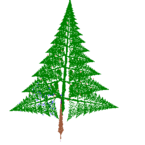Mathlapse - Patterns of Nature
film
Licence
Credits
- Authors
- Music
- Real pictures of the plants
A wonderful way to describe natural shapes using the language of mathematics is provided by self-similar patterns. The idea is to repeat the same base module on different scales and positions, following an iterative process that gives rise to very complicated and amazing results. By iterating the process infinitely many times one can often obtain a very interesting mathematical object: a fractal.
The protagonists of the Mathlapse are: Acer palmatum, Echium vulgare, Verbena Bonariensis, Pteridophyte, Hordeum vulgare L., Acer palmatum leaf.
In order to realize these shapes, one starts from a base module, composed by different lines. In the first iteration, one has to draw, for each segment, a copy of the base module; one has also to scale, translate and rotate the module depending on the position of the segment. In this way one obtains a different figure, composed by a certain number of copies of the initial module. Now it is possible to iterate the process using the same rules applied to each new segment. If the initial module is carefully chosen, the shape that is obtained after a few iterations can be very similar to some plants, or other objects which can be found in nature. By iterating the process infinitely many times one can often obtain a very interesting mathematical object: a fractal. For example, the Sierpinski triangle or the Cantor set can be obtained in this way. Is it even possible to calculate the fractal dimension of some of these fractals created with such a rule once the length of the lines and then the ratio of the scalings are known.
By adding simple rules one can obtain a complete new variety of objects. For example, a base module can have some “special” segments which “stops” the recursion; in other words they are not used for the further iterations. In this way one can create the trunk of a tree, or the stalk of a plant. By using these rules, and by considering also the length of the lines it is possible to color these self-similar shapes in a very realistic way.










































































































